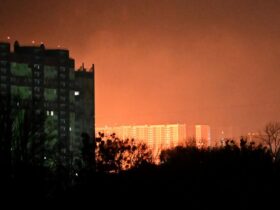W. Michael Blumenthal said, “I still remember the morning of November 10 clearly.” “My father was arrested early in the morning. Amidst the commotion and despite the fact that my mother had forbidden me to do so, I went out without looking. I saw broken shop windows on the Kurfürstendamm boulevard and smoke billowing from the synagogue on Fasanenstrasse.”
Blumenthal was only 12 years old at the time.
Jews were humiliated and beaten
On the night of November 9, 1938, Jews throughout Germany and Austria became victims of mob brutality: 1,300 synagogues and 7,500 businesses were destroyed and countless Jewish cemeteries and schools were vandalized.
Police observed Jews being humiliated in the street, beaten, and in at least 91 cases murdered. The local fire department did not prevent synagogues and Jewish shops from burning; They prevented the flames from spreading to neighboring buildings.
And that was only the beginning. On November 10, approximately 30,000 Jewish men were transported to concentration camps at Dachau, Sachsenhausen or Buchenwald.
Blumenthal’s father was one of them.
“I still remember my mother’s words when she was taken away by two policemen: ‘What’s happening? What are you doing to her? What has she done? Where is she being taken?'” Blumenthal said. “Even at 12 years old, you can feel the fear of adults.”
The rest of Blumenthal’s family managed to escape to Shanghai in 1939. It was at the time one of the only places where Jewish refugees were still allowed without a visa. Blumenthal wrote about the experience in his memoir, From Exile to Washington: A Memoir of Leadership in the Twentieth Century2014.
Why did the massacre happen on 9 November?
Physical attacks and threats targeting Jews have been widespread in Germany since the Nazis seized power in 1933.
The Nuremberg Laws, established in 1935, defined who should be considered a Jew, and many faced sudden professional restrictions. Other laws restricted their access to public places. Many Jewish properties were confiscated to be “Aryanized”.
Still, “It is important to understand November 1938 as a turning point in history,” said historian Raphael Gross, president of the Deutsches Historisches Museum (German Historical Museum) in Berlin. “After 1938, what is called the era of German Jewry ended. German society was different after that.”
The Nazis got the pretext to justify the massacre when a Jewish teenager, Hershel Grinspan, assassinated German diplomat Ernst vom Rath in Paris on November 7.
Immediately after the murder was reported by German radio, anti-Semitic riots broke out in some cities. However, two days after Hitler personally ordered it, systematic rioting began throughout Germany.
From Munich, where the entire Nazi leadership had gathered for the anniversary of the Beer Hall Putsch of 1923, the Nazi Propaganda Minister, Joseph Goebbels, wrote a speech in which he ordered that Jewish businesses should be destroyed and synagogues set on fire. The police were instructed not to interfere with the riots, and firefighters were to protect only “Aryan” property. Looting was prohibited.
Orders were put into effect that same night – not only in Berlin, but also in Cologne, Hamburg and Frankfurt, as well as smaller towns and villages throughout Germany. Blumenthal said, “For different reasons, the Germans either participated or looked away.” Not everyone agreed with what happened, but “many people just watched in silence.”
Gross said, “The massacre of November 1938 was carried out openly.” “Everyone can see it – the world’s press, foreign diplomats and all citizens.”
‘Kurfürstendamm looked like a battlefield’
Despite the official ban, looting also took place on 9 and 10 November. A report by the Brazilian Embassy Counselor mentioned gangs of youths who displayed objects of worship stolen from synagogues.
All diplomats stationed in Germany informed their home countries about the events. The report described the events as “cultural vandalism”, said historian Hermann Simon, who was director of the Centrum Judaicum for 27 years until 2015. Simon collected reports written by diplomats from 20 countries stationed in Germany in 1938.
For example, the Polish Consul General in Leipzig described the fate of the Polish Sperling family: “Sperling’s wife was stripped naked and thugs tried to rape her.”
The Latvian ambassador wrote: “The Kurfürstendamm looked like a battlefield.” The Finnish representative noted “devastating criticism” from the population. “I am ashamed to be German,” the report said, was a very common statement among the public.
How the world reacted to the actions of the Nazis
Diplomats did not send concrete demands or proposals for action to their home governments. Hermann Simon said, “They were waiting and desperately hoping that they would somehow come to an agreement with the Nazi regime.” “In that respect, the response to the reports was relatively low.”
Gross said there were some international reactions: “The Kindertransport program for England began after November 1938. Some states reacted, but it was very little.”
No one had anticipated the Nazis’ plan to exterminate the Jews, Gross said.
In a fatal misjudgment of the situation, the Italian Embassy wrote on November 16, 1938, that “it cannot be imagined that in one day 500,000 people [the approximate number of Jews living in Germany] They will be marched to the Wall, sentenced to death by hanging or suicide, or confined to vast concentration camps.”
,This article is taken from German language.
Editor’s note: This article was originally published on November 8, 2018 and was updated on November 8, 2023. The wording was changed to reflect the fact that the terms “Kristallnacht” or “Night of Broken Glass” are considered trivial today. The events of November 9, 1938 are now known as the “Reichspogromnacht” or November Pogroms.
It was republished on November 9, 2025.






Leave a Reply